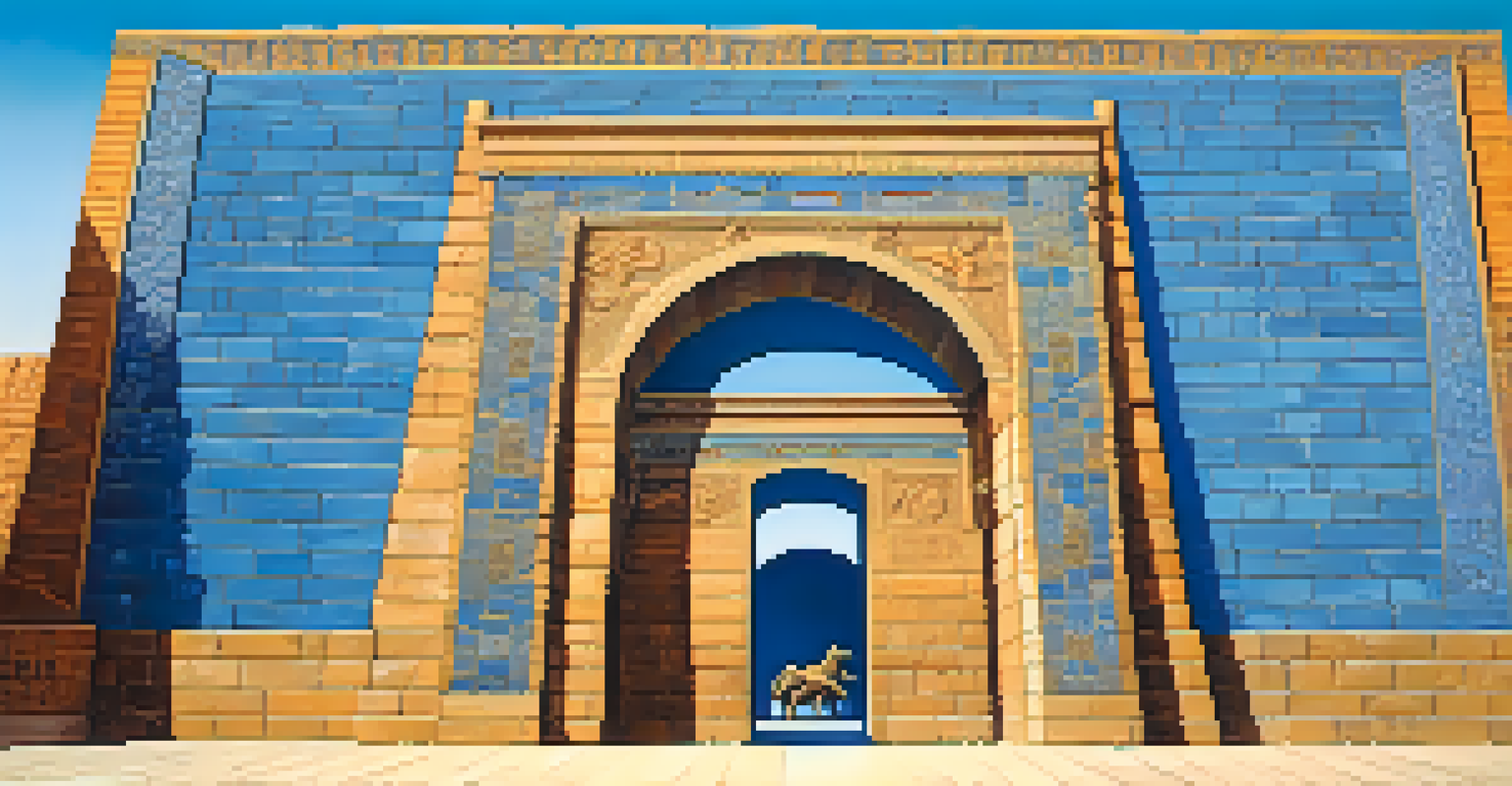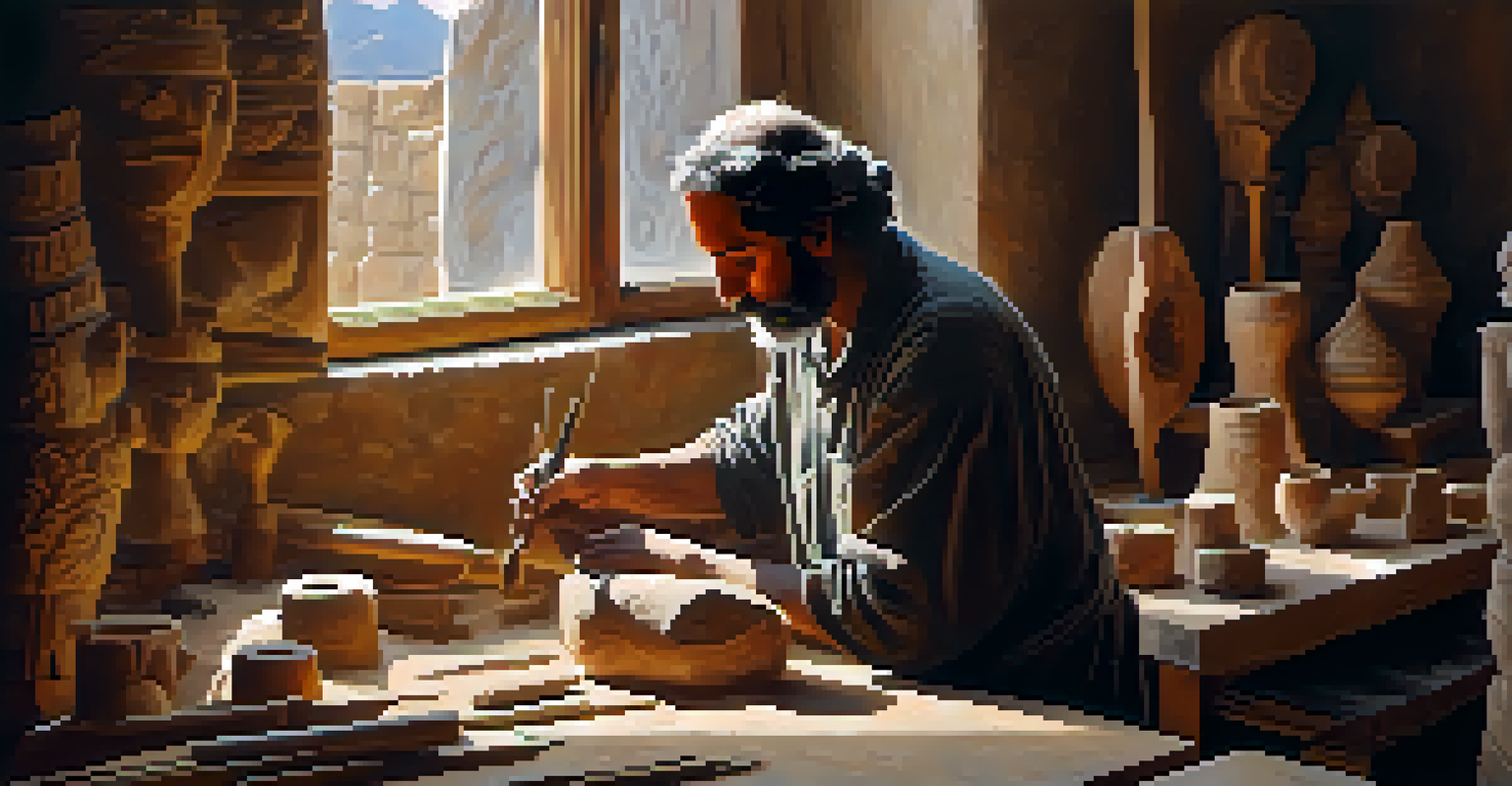Exploring Ancient Carving Techniques in Mesopotamia History

The Significance of Carving in Mesopotamian Culture
In ancient Mesopotamia, carving was more than just an art form; it was a vital part of their culture and communication. These intricate artworks often depicted gods, mythological scenes, and everyday life, serving as a window into the civilization's beliefs and practices. Carvings were typically done on stone, clay, or wood, and they played a significant role in temples, palaces, and even in private homes, showcasing the skill of the artisans.
Art is a reflection of the culture that creates it.
The significance of these carvings cannot be overstated; they were a means of storytelling and preserving history. For instance, the famous stele of Hammurabi not only displays the law code but is also a striking example of how carving served to convey important societal messages. Through these carvings, we can gain insights into the social structure, religion, and daily life of the people who inhabited this region thousands of years ago.
Moreover, these artistic expressions fostered a sense of identity and continuity for the Mesopotamian people. As generations passed, the techniques and styles evolved, yet the core purpose remained: to connect with the divine and commemorate significant events. This rich tradition laid the foundation for future artistic endeavors in the region and beyond.
Materials Used in Mesopotamian Carving
Mesopotamian artisans had access to a variety of materials, each chosen for its suitability and durability. Stone, particularly limestone and alabaster, was favored for its strength and ability to hold fine details, making it ideal for sculptures and bas-reliefs. Clay was also commonly used, especially for smaller pieces, as it was readily available and easy to mold, allowing for more experimentation in design.

Wood, although less durable, was utilized for creating intricate carvings in furniture and decorative items. The use of wood allowed artisans to explore different textures and forms that stone could not provide. Each material brought unique qualities to the final pieces, influencing their appearance and longevity.
Carvings as Cultural Expression
In Mesopotamia, carvings were vital for storytelling and preserving history, reflecting societal beliefs and practices.
The choice of materials also reflected the social and economic status of the patron. Wealthier individuals could commission elaborate stone carvings, while everyday people might opt for clay or wooden items. This variation in materials highlights the diverse artistic practices within Mesopotamia and underscores the importance of resource availability in shaping their artistic legacy.
Techniques Employed by Mesopotamian Artisans
Mesopotamian carving techniques were diverse and sophisticated, reflecting the skill and creativity of the artisans. One prevalent method was bas-relief, where figures were carved into a flat surface, creating a three-dimensional effect. This technique allowed artists to depict depth and perspective, making scenes appear more lifelike and engaging.
The past is never dead. It's not even past.
Another technique involved intaglio, where designs were incised into the material, creating a sunken effect. This method was often used for seals, which played a crucial role in administration and trade, as they bore the owner's mark. These seals not only served a functional purpose but also showcased the artistry of the carver, often featuring intricate designs and symbols.
The use of tools such as chisels and mallets was essential in these carving processes. Artisans learned to wield these tools with precision, enabling them to create detailed images that conveyed their intended message. Over time, these techniques developed, influencing not only Mesopotamian art but also the broader artistic traditions in the region.
Famous Carvings and Their Historical Context
Several iconic carvings from Mesopotamia have survived the test of time, each telling its own unique story. The Ishtar Gate, adorned with beautiful blue glazed bricks and reliefs of dragons and bulls, was a monumental entrance to the city of Babylon. This grand structure reflected the power of King Nebuchadnezzar II and the importance of the goddess Ishtar in Babylonian culture.
Another notable example is the Assyrian wall reliefs, which depicted scenes of hunting and battle, symbolizing the king's might and divine favor. These intricate carvings not only served decorative purposes but also functioned as propaganda, reinforcing the king's strength and authority over his enemies. They offer a glimpse into the societal values and priorities of the time.
Diverse Materials and Techniques
Artisans utilized various materials like stone, clay, and wood, employing sophisticated techniques to create intricate designs.
These famous artworks serve as crucial historical documents, providing context to the political and religious landscape of ancient Mesopotamia. They remind us of the civilization's artistic achievements and the ways in which they sought to immortalize their stories through stone.
The Role of Religion in Mesopotamian Carving
Religion was a central aspect of life in ancient Mesopotamia, and carving played a significant role in its expression. Many carvings depicted deities, rituals, and mythological scenes, reflecting the society's deep spiritual beliefs. Temples were often adorned with elaborate carvings that served both as decoration and as a means of worship, inviting the divine into the physical space.
The portrayal of gods and goddesses in art was not only a way to honor them but also to communicate their attributes and powers. For example, carvings of the goddess Inanna often depicted her in powerful poses, symbolizing fertility and war, which were integral to the Mesopotamian worldview. These representations helped to solidify the connection between the divine and the earthly realm.
Moreover, the carvings served as a means of educating the populace about their beliefs and practices. By illustrating myths and religious narratives, artisans helped to pass down cultural values and traditions through generations. This intertwining of art and religion enriched the Mesopotamian experience, making their carvings a vital part of their spiritual legacy.
The Influence of Mesopotamian Carving on Future Cultures
The artistic legacy of Mesopotamia extended far beyond its borders, influencing neighboring cultures and future civilizations. The techniques and styles developed by Mesopotamian artisans laid the groundwork for subsequent artistic movements in places like Persia and Greece. This exchange of ideas helped to create a rich tapestry of artistic expression throughout the ancient world.
For instance, the use of bas-relief became a hallmark of later cultures, with the Greeks adopting and adapting these techniques in their own sculptures and architectural designs. The emphasis on realism and detail seen in Mesopotamian carvings set a standard that would be pursued by artists for centuries to come.
Religious Themes in Art
Religious beliefs heavily influenced Mesopotamian carvings, integrating divine representations and cultural narratives into their artwork.
In addition to technique, the themes depicted in Mesopotamian carvings also resonated with later cultures. The representation of gods, myths, and heroic figures continued to be central to artistic expression, demonstrating the enduring impact of Mesopotamian art on the collective human experience. This cultural exchange reminds us of the interconnectedness of civilizations throughout history.
Preservation and Study of Mesopotamian Carvings Today
As we explore the world of Mesopotamian carving today, the importance of preservation and study cannot be overlooked. Many ancient artifacts have been uncovered in archaeological sites, providing valuable insights into the techniques and cultural significance of these carvings. Museums and institutions around the world work diligently to conserve these pieces, ensuring they remain accessible for future generations.
Modern technology has also played a pivotal role in the study of Mesopotamian carvings. Techniques such as 3D scanning and digital imaging allow researchers to analyze details that may not be visible to the naked eye. This technological advancement enhances our understanding of the craftsmanship and artistry involved in creating these ancient works.

Furthermore, the study of these carvings continues to inspire artists and historians alike. By examining the past, we gain a deeper appreciation for the creativity and ingenuity of Mesopotamian artisans, reminding us of the timeless nature of art and its ability to connect us across time and space. The legacy of Mesopotamian carving remains alive, encouraging us to explore our own artistic expressions.